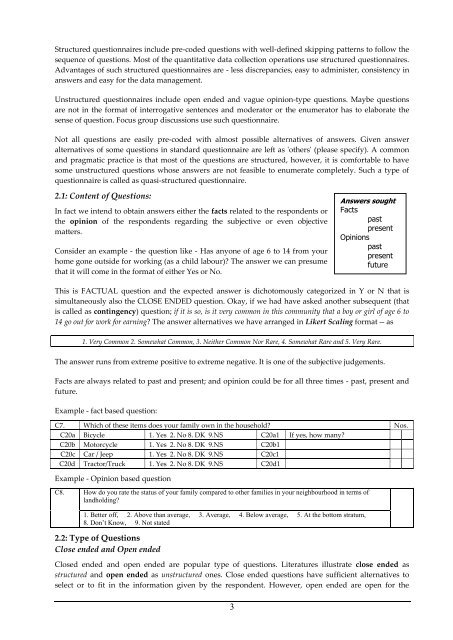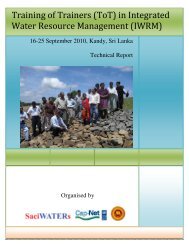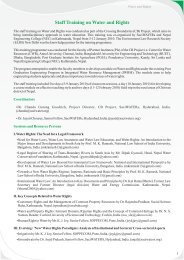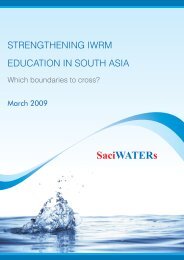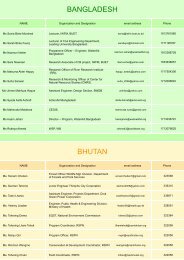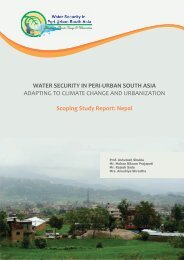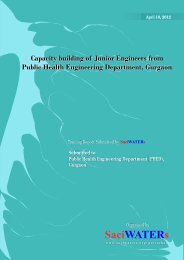Questionnaire Design: The Backbone of Reseach - SaciWATERs
Questionnaire Design: The Backbone of Reseach - SaciWATERs
Questionnaire Design: The Backbone of Reseach - SaciWATERs
Create successful ePaper yourself
Turn your PDF publications into a flip-book with our unique Google optimized e-Paper software.
Structured questionnaires include pre-coded questions with well-defined skipping patterns to follow the<br />
sequence <strong>of</strong> questions. Most <strong>of</strong> the quantitative data collection operations use structured questionnaires.<br />
Advantages <strong>of</strong> such structured questionnaires are - less discrepancies, easy to administer, consistency in<br />
answers and easy for the data management.<br />
Unstructured questionnaires include open ended and vague opinion-type questions. Maybe questions<br />
are not in the format <strong>of</strong> interrogative sentences and moderator or the enumerator has to elaborate the<br />
sense <strong>of</strong> question. Focus group discussions use such questionnaire.<br />
Not all questions are easily pre-coded with almost possible alternatives <strong>of</strong> answers. Given answer<br />
alternatives <strong>of</strong> some questions in standard questionnaire are left as 'others' (please specify). A common<br />
and pragmatic practice is that most <strong>of</strong> the questions are structured, however, it is comfortable to have<br />
some unstructured questions whose answers are not feasible to enumerate completely. Such a type <strong>of</strong><br />
questionnaire is called as quasi-structured questionnaire.<br />
2.1: Content <strong>of</strong> Questions:<br />
In fact we intend to obtain answers either the facts related to the respondents or<br />
the opinion <strong>of</strong> the respondents regarding the subjective or even objective<br />
matters.<br />
Consider an example - the question like - Has anyone <strong>of</strong> age 6 to 14 from your<br />
home gone outside for working (as a child labour)? <strong>The</strong> answer we can presume<br />
that it will come in the format <strong>of</strong> either Yes or No.<br />
Answers sought<br />
Facts<br />
past<br />
present<br />
Opinions<br />
past<br />
present<br />
future<br />
This is FACTUAL question and the expected answer is dichotomously categorized in Y or N that is<br />
simultaneously also the CLOSE ENDED question. Okay, if we had have asked another subsequent (that<br />
is called as contingency) question; if it is so, is it very common in this community that a boy or girl <strong>of</strong> age 6 to<br />
14 go out for work for earning? <strong>The</strong> answer alternatives we have arranged in Likert Scaling format -- as<br />
1. Very Common 2. Somewhat Common, 3. Neither Common Nor Rare, 4. Somewhat Rare and 5. Very Rare.<br />
<strong>The</strong> answer runs from extreme positive to extreme negative. It is one <strong>of</strong> the subjective judgements.<br />
Facts are always related to past and present; and opinion could be for all three times - past, present and<br />
future.<br />
Example - fact based question:<br />
C7. Which <strong>of</strong> these items does your family own in the household? Nos.<br />
C20a Bicycle 1. Yes 2. No 8. DK 9.NS C20a1 If yes, how many?<br />
C20b Motorcycle 1. Yes 2. No 8. DK 9.NS C20b1<br />
C20c Car / Jeep 1. Yes 2. No 8. DK 9.NS C20c1<br />
C20d Tractor/Truck 1. Yes 2. No 8. DK 9.NS C20d1<br />
Example - Opinion based question<br />
C8. How do you rate the status <strong>of</strong> your family compared to other families in your neighbourhood in terms <strong>of</strong><br />
landholding?<br />
1. Better <strong>of</strong>f, 2. Above than average, 3. Average, 4. Below average, 5. At the bottom stratum,<br />
8. Don’t Know, 9. Not stated<br />
2.2: Type <strong>of</strong> Questions<br />
Close ended and Open ended<br />
Closed ended and open ended are popular type <strong>of</strong> questions. Literatures illustrate close ended as<br />
structured and open ended as unstructured ones. Close ended questions have sufficient alternatives to<br />
select or to fit in the information given by the respondent. However, open ended are open for the<br />
3


